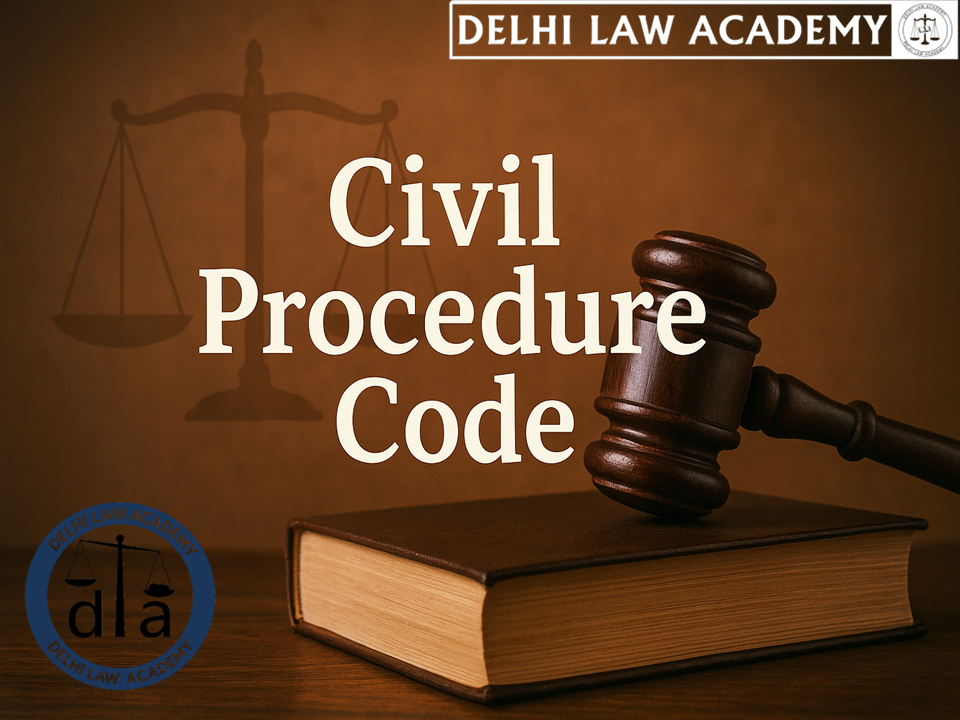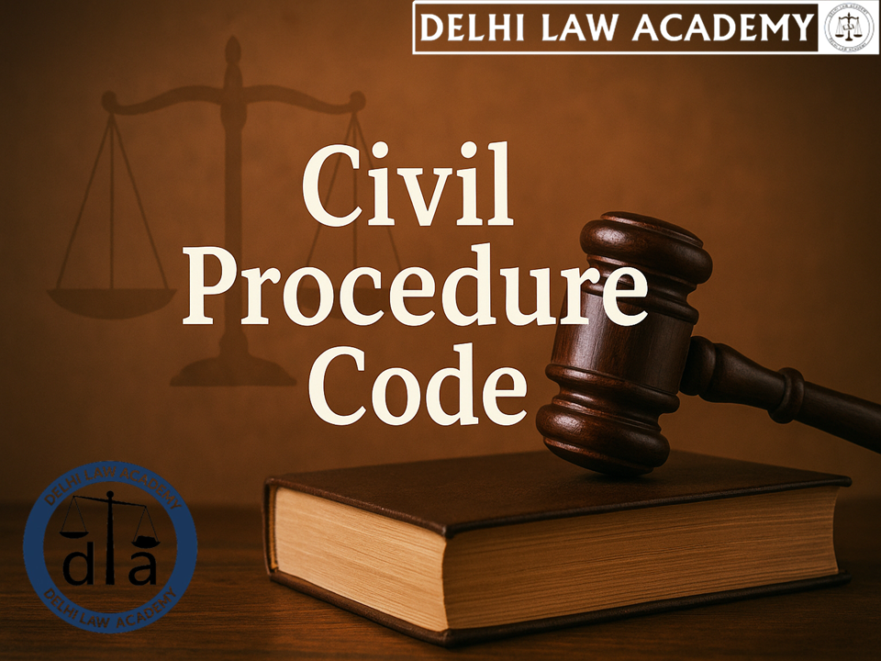
⚖️ CIVIL PROCEDURE CODE : SECTION 10 CPC : STAY OF SUIT ⚖️
📘 TOPICS
- Object of section 10 CPC
- Meaning of ‘trial’ in section 10 CPC
- Whether the bar to proceed with the trial of subsequently instituted suit, contained in Section 10 of the Code of Civil Procedure is applicable to a summary suit filed under Order 37 of the Code?
- Section 10 CPC v. Order 37
📜 SUPREME COURT JUDGMENT ON SECTION 10 CPC
- Indian Bank v. Maharashtra Co-Op. Marketing Federation [1998 SC]
🎯 Preparation for RJS, DJS, PCS (J) and other Judicial Service exams
CIVIL PROCEDURE CODE EXPLAINED
The Civil Procedure Code forms the bedrock of any and every Judicial Service exam in the country. Its thorough knowledge is a must for all aspirants of RJS, DJS, PCS (J) and every other Judicial Service exam. To help such aspirants, DELHI LAW ACADEMY JAIPUR has launched a series of study material modules on all important aspects of this vital part of their syllabus:
⚖️ STAY OF SUIT
Section 10
- No Court shall proceed with the trial of any suit
- in which the matter in issue is also directly and substantially in issue
- in a previously instituted suit between the same parties or between parties under whom they claim
- where such suit is pending
- in the same or any other Court in India or
- before the Supreme Court
Explanation
- Pendency of a suit in a foreign Court
- does not preclude Courts in India
- from trying a suit founded on the same cause of action
📘 Explanatory Notes from Delhi Law Academy Jaipur on Section 10
🎯 Object of section 10
- The object of the prohibition contained in Section 10 is to prevent the Courts of concurrent jurisdiction from simultaneously trying two parallel suits and also to avoid inconsistent findings on the matters in issue.
- The provision is in the nature of a rule of procedure and does not affect the jurisdiction of the Court to entertain and deal with the later suit nor does it create any substantive right in the matters.
- It is not a bar to the institution of a suit.
- It has been construed by the Courts as not a bar of the passing of interlocutory orders such as an order for consolidation of the later suit with the earlier suit or appointment of a Receiver or an injunction or attachment before judgment.
- The course of action which the Court has to follow according to Section 10 is not to proceed with the ‘trial’ of the suit but that does not mean that it cannot deal with the subsequent suit any more or for any other purpose.
⚖️ Meaning of ‘trial’ in section 10
- The word ‘trial’ is no doubt of a very wide import. In legal parlance it means a judicial examination and determination of the issue in civil or criminal Court by a competent Tribunal.
- According to Webster Comprehensive Dictionary, it means the examination, before a tribunal having assigned jurisdiction, of the facts or law involved in an issue in order to determine that issue.
- Thus in its widest sense it would include all the proceedings right from the stage of institution of a plaint in a civil case to the stage of final determination by a judgment and decree of the Court.
- The word “trial” in Section 10 will have to be interpreted and construed keeping in mind the object and nature of that provision.
🧩 Question:
- Whether the bar to proceed with the trial of subsequently instituted suit, contained in Section 10 of the Code of Civil Procedure is applicable to a summary suit filed under Order 37 of the Code?
Ans:
- The Court dealing with the summary suit can proceed up to the stage of hearing the summons for judgment and passing the judgment in favour of the plaintiff if
- (a) the defendant has not applied for leave to defend or if such application has been made and refused or
- (b) the defendant who is permitted to defend fails to comply with the conditions on which leave to defend is granted
📚 Case Study: Indian Bank v. Maharashtra Co-Op. Marketing Federation [1998 SC]
Facts of the case
- The respondent Federation applied to the appellant Bank on 5-6-1989 to open an Irrevocable Letter of Credit in favour of M/s. Shankar Rice Mills.
- Pursuant to that request the Bank opened an Irrevocable Letter of Credit on 6.6.1989.
Summary suit by the Bank:
- On 6.2.1992 the Bank filed a summary suit in Bombay High Court under Order 37 against the Federation for obtaining a decree of Rs. 4,96,58,160 alleging that the said amount has become recoverable under the said Letter of Credit. The Bank took out summons for judgment.
Federation had already filed a suit…
- The Federation appeared before the Court and took out Notice of Motion seeking stay of the summary suit on the ground that it has already instituted a suit against the Bank for recovery of Rs. 3,70,52,217 prior to the filing of the summary suit.
Single judge high court…
- A Single Judge of Bombay High Court who heard the summons for judgment held that the concept of trial as contained in Section 10 of the Code is applicable only to a regular/ordinary suit and not to a summary suit filed under Order 37 of the Code and, therefore, further proceedings under Summary Suit were not required to be stayed.
Division Bench…
- The Division Bench was of the view that the word “trial” in Section 10 would mean the entire proceedings after the defendant enters his appearance.
- It held that the summary suit filed by the Bank being a subsequently instituted suit was required to be stayed.
Supreme Court
Section 10 v. Order 37
- The provision contained in Section 10 is a general provision applicable to all categories of cases.
- The provisions contained in Order 37 apply to certain clauses of suits.
- One provides a bar against proceeding with the trial of a suit, the other provides for granting of quick relief.
- Both these provisions have to be interpreted harmoniously so that the objects of both are not frustrated.
Judgment:
- The stage of determination of the matter in issue will arise in a summary suit only after the defendant obtains leave. The trial would really begin only after leave is granted to the defendant.
- The word ‘trial’ in Section 10 in the context of a summary suit cannot be interpreted to mean the entire proceedings starting with institution of the suit by lodging a plaint.
📚 Continue Your CPC Preparation
Don’t stop here! Strengthen your knowledge of the Civil Procedure Code with our other fully solved tests:
📘 Free Study Material for Judiciary Aspirants!
Download our FREE study material prepared by Delhi Law Academy’s expert faculty.
❓ Frequently Asked Questions on Section 10 CPC
Contact us
📍 Delhi Law Academy – Jaipur Branch
6C, Tower 2, Coaching Hub, Pratap Nagar, Jaipur – 302033
📞 Phone:
+91 9911916552
+91 8447285606
✉️ Email:
contactus@delhilawacademy.com

